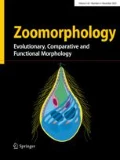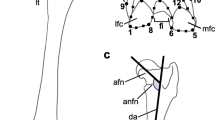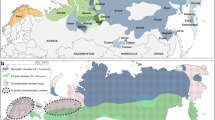Abstract
The mammalian Carpus is a complex of several small bones with multiple interactions during walking. Therefore, it is highly probable that different mammalian families developed distinctive constellations in their Carpi, which could be useful for biometric identification of phylogenetic groupings. The carpal bones of nineteen extant ruminant species (nine bovid, nine cervid, and one moschid) have been investigated to search for biometric traits which are diagnostic for the three families. Additionally, we searched for diverging functional adaptations in the carpal constellations. Therefore, measurements have been taken from the five main carpals, which are carrying the body weight. As a sesamoid bone, Os carpi accessorium was excluded. After transformation of the data into their natural logarithms, multivariate methods of factor analyses and discriminant analyses were performed for each bone. Bivariate plots of the factor scores allowed a clear separation of bovids and cervids. The only one species of the Moschidae (Moschus moschiferus) lies closer to the cervids than to the bovids. The grouping is due to phylogenetic relationships and not due to functional differences in the groups or differing habitat preferences. Generally, the carpals of cervids are more slender and higher in contrast to the bulky and flat carpals in bovids. This approach could be used to assign isolated carpal bones found in fossil sites to their ruminant family.




Similar content being viewed by others
References
Agnarsson I, May-Collado LJ (2008) The phylogeny of Cetartiodactyla: the importance of dense taxon sampling, missing data, and the remarkable promise of cytochrome b to provide reliable species-level phylogenies. Mol Phylogenet Evol 48:964–985. doi:10.1016/j.ympev.2008.05.046
Bininda-Emonds ORP, Cardillo M, Jones KE, MacPhee RDE, Beck RMD, Grenyer R, Price SA, Vos RA, Gittleman JL, Purvis A (2007) The delayed rise of present-day mammals. Nature 446:507–512. doi:10.1038/nature05634
Di Stefano G, Petronio C (2003) Systematics and evolution of the Eurasian Plio-Pleistocene tribe Cervini (Artiodactyla, Mammalia). Geol Romana 36:311–334
Döppes D (1997) Die jungpleistozäne Säugetierfauna der Gudenushöhle (Niederösterreich). Wiss Mitt Niederösterr Landesmuseum 10:17–32
Galik A (1997) Die Ungulata aus der Schusterlucke im Kremstal (Waldviertel, Niederösterreich). Wiss Mitt Niederösterr Landesmuseum 10:83–103
Guha S, Goyal SP, Kashyap VK (2007) Molecular phylogeny of musk deer: a genomic view with mitochondrial 16S rRNA and cytochrome b gene. Mol Phylogenet Evol 42:585–597. doi:10.1016/j.ympev.2006.06.020
Hassanin A, Douzery EJP (2003) Molecular and morphological phylogenies of Ruminantia and the alternative position of the Moschidae. Syst Biol 52:206–228. doi:10.1080/10635150390192726
Hassanin A, Delsuc F, Ropiquet A, Hammer C, Jansen van Vuuren B, Matthee C, Ruiz-Garcia M, Catzeflis F, Areskoug V, Nguyen TT, Couloux A (2012) Pattern and timing of diversification of Cetartiodactyla (Mammalia, Laurasiatheria), as revealed by a comprehensive analysis of mitochondrial genomes. C R Biol 335:32–50. doi:10.1016/j.crvi.2011.11.002
Hildebrand M, Goslow GE (2001) Analysis of vertebrate structure, 5th edn. Wiley, New York
Hughes S, Hayden TJ, Douady CJ, Tougard C, Germonpré M, Stuart A, Lbova L, Carden RF, Hänni C, Say L (2006) Molecular phylogeny of the extinct giant deer, Megaloceros giganteus. Mol Phylogenet Evol 40:285–291. doi:10.1016/j.ympev.2006.02.004
Janis CM (1988) New ideas in ungulate phylogeny and evolution. Trends Ecol Evol 3:291–297
Janis CM, Scott KM (1987) The interrelationships of higher ruminant families with special emphasis on the members of the Cervoidea. Am Mus Novit 2893:1–85
Janis CM, Scott KM (1988) The phylogeny of the Ruminantia (Artiodactyla, Mammalia). In: Benton MJ (ed) The phylogeny and classification of the tetrapods, 2. Clarendon Press, Oxford, pp 273–282
Kappelman J (1988) Morphology and locomotor adaptations of the bovid femur in relation to habitat. J Morphol 198:119–130
Kappelman J (1991) The paleoenvironment of Kenyapithecus at Fort Ternan. J Hum Evol 20:95–129
Köhler M (1993) Skeleton and habitat of recent and fossil ruminants. Münchner Geowiss Abh A 25:1–88
Leinders JJM, Heintz E (1980) The configuration of the lacrimal orifice in pecorans and tragulids (Artiodactyla, Mammalia) and its significance for the distinction between Bovidae and Cervidae. Beaufortia 30(7):155–162
Martin T (1987) Artunterschiede an den Langknochen großer Artiodactyla des Jungpleistozäns Mitteleuropas. Cour Forschungsinst Senckenb 96:1–124
McKenna MC, Bell SK (1997) Classification of Mammals above the species level. Columbia University Press, New York
Nickel R, Schummer A, Seiferle E (2004) Lehrbuch der Anatomie der Haustiere. Band 1: Bewegungsapparat, 8th edn. Parey Verlag, Stuttgart
Nowak RM (1991) Walker’s mammals of the world, 5th edn. Johns Hopkins University Press, Baltimore
Pitra C, Fickel J, Meijaard E, Groves CP (2004) Evolution and phylogeny of old world deer. Mol Phylogenet Evol 33:880–895. doi:10.1016/j.ympev.2004.07.013
Randi E, Mucci N, Claro-Hergueta F, Bonnet A, Douzery EJP (2001) A mitochondrial DNA control region phylogeny of the Cervinae: speciation in Cervus and implications for conservation. Anim Conserv 4:1–11. doi:10.1017/S1367943001001019
Schellhorn R (2009) Eine Methode zur Bestimmung fossiler Habitate mittels Huftierlangknochen. Dissertation, Eberhard Karls Universität, Tübingen, http://nbn-resolving.de/urn:nbn:de:bsz:21-opus-39180
Schloeth R (1988) Damhirsche (Gattung Dama). In: Grzimek B (ed) Grzimeks Enzyklopädie Säugetiere, vol 5. Kindler, München, pp 151–161
Schmid E (1972) Atlas of animal bones: for prehistorians, archaeologists and quaternary geologists. Elsevier, Amsterdam
Soergel W (1928) Ein kleiner Wolf aus den Kiesen von Süßenborn. Z Deutsch Geol Ges 80:227–237
Starck D (1979) Vergleichende Anatomie der Wirbeltiere auf evolutionsbiologischer Grundlage. Bd.2 Das Skeletsystem: Allgemeines, Skeletsubstanzen, Skelet der Wirbeltiere einschließlich Lokomotionstypen. Springer, Berlin
Yalden DW (1971) The functional morphology of the carpus in ungulate mammals. Acta Anat 78:461–487
Acknowledgments
We thank Erich Weber and Jürgen Rösinger (both ZSTÜ), and Rainer Hutterer (ZFMK) for access to the material. We also thank two anonymous reviewers for helpful comments to the manuscript.
Author information
Authors and Affiliations
Corresponding author
Additional information
Communicated by A. Schmidt-Rhaesa.
Rights and permissions
About this article
Cite this article
Schellhorn, R., Pfretzschner, HU. Biometric study of ruminant carpal bones and implications for phylogenetic relationships. Zoomorphology 133, 139–149 (2014). https://doi.org/10.1007/s00435-013-0209-0
Received:
Revised:
Accepted:
Published:
Issue Date:
DOI: https://doi.org/10.1007/s00435-013-0209-0




